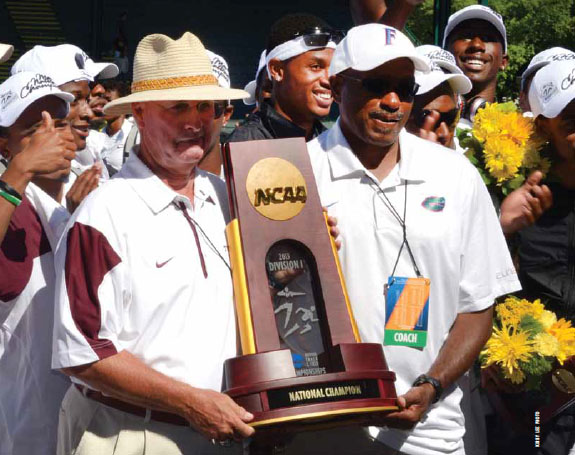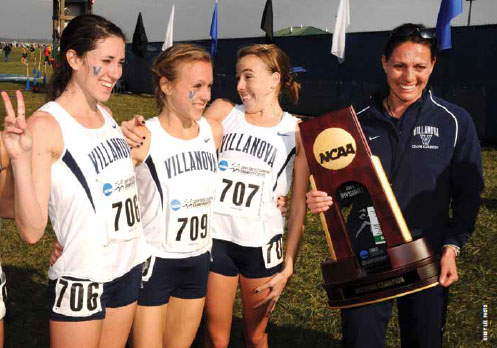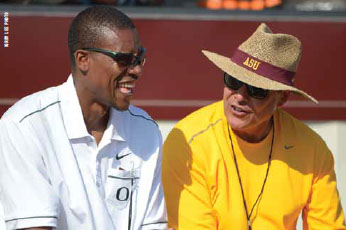| A COACH’S Leadership -
Originally Published in Techniques Magazine - Provided by: USTFCCCA
 The track and field teams that consistently finish in the top four or five in national competitions year in and year out may not simply be a matter of recruiting and resources alone. Rather, these programs are based on a systematic and deliberate leadership style developed by successful coaches. Regardless of resources and funding, every coach can become successful by developing leadership competencies necessary to be successful in today's competitive world by following a systematic process. In studying corporate business management data, there tends to be a consistent pattern that frequently indicates that leadership development is a systematic procedure and can be effective in athletic coaching. One would be able to refine their leadership styles by following a four-step process. The process must be defined and presented in order for anyone to develop the necessary leadership skills for success. The Leadership Process is developed by: STEP 1: ESTABLISHING CREDIBILITY Expand one's knowledge of specific programmatic needs and athlete expectations. In order to be successful, the leader-coach must identify and understand the athletic training model from ground level fundamentals to the elite level specifics, having full knowledge of the processes and procedures. Credibility is established by proving to his or her constituents that the leader-coach has the expert knowledge to understand athletic performance and productivity. By proving the leader has the expert knowledge to understand performance, knowledge of the event areas, and how they are governed by each of the sports sciences is essential in developing trust from the athletes which can lead to optimum performance. In addition, the leader-coach must understand what resources are needed and which are essential in developing the bio-motor competencies of the athletes. Decisions based on knowledge of athletic protocols and other indicators of success will be supported and championed by those that share the vision of success for the team. Trust competencies and personal skills that help develop confidence in one's actions and behaviors. Trust one's experience and continue to develop and explore innovative approaches to problem solving and success. The leader-coach that is confident and shows assertiveness is extremely effective. The true leader is able to build upon previous successes and failures to adjust his or her programs to be innovative and progressive. Elimination of the previous failures by substituting new ideas and experimentation can be of superior benefit to developing a successful program and yet maintain confidence in one's self. Expand one's knowledge of management and leadership theories by studying previous models of past successful team performances to determine the qualities and traits exhibited by leaders who have experienced success. Read, research and apply principles of learning based on successful coaches and their programs that perennially are in the spotlight as it relates to national and international success. Research of highly successful programs is needed to develop a philosophy that includes a personalized plan tailor-made for the ability level of the athlete and resources available for one's specific group each year. Focus on a research plan using an eclectic form of leadership behaviors of identified successful coaches and national perennial powers to develop a personal style true to oneself. The leader should attend and complete certifications and trainings in their area of expertise. Coaching education programs and certifications are available by professional associations affiliated with the sport, such as the US Track and Field and Cross Country Coaches Association (USTFCCCA), the National Governing Bodies (NGB), as well as private, for profit coaching schools and clinics. Corporate business leadership programs like the True Growth Academy would also provide expertise in developing leadership traits. These types of training are extremely necessary for continuing education and personal development. STEP 2: SMING A CLEAR VISION AND PURPOSE Successful leaders are experts at establishing team goals, setting objectives and creating the vision necessary for optimum and peak performances. In addition, leaders are skilled in establishing individual goals based on each athlete's potential and competencies by virtue of assessments and athletic measurements that identify potential. Daily reinforcement, monthly feedback, analysis and training phase projections help to define a clear path with purpose and an end result in sight. The vision must be realistic, yet challenging, with a projected plan to indicate that the vision can be achieved through hard work and dedication. Leader-coaches are masters in the scheduling of competitions, knowing which meets are important and which meets can be used for developmental purposes. It is extremely important to understand the concept of periodization and training plans that provides a proper direction or path and is the technical component of developing a vision or goal. A fundamentally sound periodized training program with goals, objectives, milestones and constant feedback is necessary to gain the confidence of the athletes. Each event area should have a detailed plan, including the expectations for each cycle of training. There should be sound principles in place to depict each Phase, Macro-cycle, Micro-cycle, Sessions and Units with specific milestones to reach in each cycle. Leaders should express their personal goals and vision to ensure that others know the direction and purpose of one's actions. Leadership many times has been defined by "setting the example" and should not be taken lightly. Coaches are in the spotlight and eyes are watching to see if the leader is ethical and has established principles. The true leader realizes that expressing and living their personal purpose can help improve his or her professional life. Therefore, the leader should be willing to align one's career with one's life purpose to develop a balanced approach in order to establish authentic behaviors that can be trusted and respected.  STEP 3: BEING ACCESSIBLE AND APPROACHABLE The coach-athlete relationship should be personal yet professional and must be governed by ethical behavior. This relationship should be carefully developed to provide the athlete with a mentor or guide for not only sport, but also in life. Each athlete must be treated with respect as the leader must assume he or she is giving their best and working toward his or her personal and team goals and visions. The walk-on should receive the same respect and consideration as the elite athlete. If favoritism occurs, it will be quite evident and transparent. Coaches will lose their credibility and trust with different and varying levels of athlete treatment. Always be in contact with each athlete and support them not only in their athletic endeavors, but also their personal lives as well. Of course, there is a limit to how far one should take a personal interest, but honest ethical behavior is expected of a true leader. Each athlete's welfare and well-being should be addressed and taken as personal and confidential. STEP 4: DEVELOP CLEAR AND CONCISE COMMUNICATION Communication channels should be transparent and specific with clear and concise verbiage and vocabulary. Intentions and purposes of the message should align with the visions and objectives of the athletic program and team goals. The messages should relate to the goals and expectation of the tasks assigned and based on the credibility of the leader. The leader should ensure the proper selection of understandable terminology for transference of technique into action. In other words, the communication should be familiar with the athlete and his or her understanding. Ensure communication is dynamic and energetic within the proper context of the mission and purpose. Show passion in the purpose of the communication. Communication should be proactive and assertive, yet engaging as a communicator with inspiration as its most important objective. Develop a method of communication that addresses proper tone, pitch, and rate of speech that is assertive and decisive. An improper tone can convey an unintended message. Become an expert in receiving feedback on how athletes relate to your communication style. Develop a communication strategy to express one's openness to listening and validating others' feedback during communication and rely on feedback to help shape the individual's training plan. Provide others the opportunities to feel confident in expressing their views and ideas and be prepared to listen. Keep an open mind and validate the athlete's ideas and suggestions. Schedule one-on-one meetings to discuss training plans, academic endeavors or, on occasion, personal issues. Communicate your ideas and trust your decision-making process in a way that shows initiative and decisiveness without threat to others. Every decision should reflect the vision and purpose of the program. Identify the problem, analyze the issue, and provide recommendations for improvement. Be innovative and change the previous weakness or behavior and provide a proactive solution to improve one's competencies. Develop a method of non-verbal communication that can be used during "on the field" competition. Coaches are usually restricted to where they may sit or be located in the grandstand and are unavailable to convey verbal instructions. Sign language, as well as non-verbal gestures or cues, is absolutely necessary to establish communication from long distances. A "cue" system should be in place to indicate a symbol or gesture that initiates a particular action. A critical competency for a leader is to establish and communicate an environment that promotes the inspiration for success and internally motivates the athlete. One should realize that motivation is from within; coaches who use methods to motivate athletes using fear or strict discipline usually find that the performance gained is stained with emotional side effects. Coaches must develop the skills to inspire athletes to motivate themselves to greatness, step aside and realize the true purpose of coaching. Develop patience and understanding when mistakes are made. Keep the emotion from conveying an unintended message. RESULTS OF FOLLOWING THE FOUR-STEP PROCESS: A result of the four-step process is a development of trust between the coach and athlete. If the coach's ego or self-promoting factors are evident, trust and faith are lost. If the coach places his or her own agenda first, it leads to a downfall of trust and results in mistrust and lack of sincerity. Once trust is lost it is extremely difficult to regain, so much in fact that athletes, as well as administrators and peers, see through the individual and realize that the vision and purpose is designed for the wrong reasons. The leader must be conscience of maintaining humility, yet establish confidence in their abilities and still remain expressive and confident in his or her decisions. The leader who exhibits integrity and purpose will be respected and admired by athletes, administrators and the public. They and they alone can hold themselves accountable for what actions and directions that they take. Criticism from outside sources is considered, but do not steer the true leader from his or her purpose and vision. RESPECT IS ESTABLISHED Acquisition of respect from athletes and the public at large can be expected with following the process as well. Trust will be solidified through the four-step approach and respect for the individual will be of utmost importance. Respect must be earned. Through the right process with the right purpose and attitude, one will develop a lifelong relationship with their athletes. They will always look to their coaches as their "leader-coach" or mentor and even at times ask your advice long after the competitive athlete transitions into life. AUTHENTICITY IS ESTABLISHED The true authentic and humble leader-coach will develop and maintain personal integrity, exhibit reliable behavior and be consistent in actions, words and deeds. They will be able to celebrate success with a selfless attitude and give credit when credit is due. Realizing that the limelight and recognition are usually a result of the commitment of the athlete and the team, leader-coaches are willing to accept the responsibility of recognition. They can be proud of their accomplishments and develop self-confidence without being conceited and know that their efforts have been justified. They will be able to exhibit behaviors that protect confidentiality and trust to foster a caring relationship that can last a lifetime.
REFERENCES Anderson, S. On judging and being judged accurately in zero-acquaintance situations. Journal of Personality and Social Psychology, 46, 294-307: 1984. Baggett, B. True Growth Academy www.byrdbaggett.com: 2012 Bandura, A. Self-efficacy: Toward a unifying theory of behavioural change. Psychological Review, 84, 191-215: 1977 Branden, N. The psychology of self-esteem. New York: Bantam: 1969 http://www.inter-disciplinay.net/:2012 Maslow A.H. Motivation and Personality (3rd ed.) New York: Harper & Row: 1987 Nucci, C. Improving socialization through sport: an analytic review of literature on aggression and sportsmanship.. The Physical Educator: 62(3), 123-129.: 2005. Sefcik, G. Independent Research www.coachinet.net Shaikh, P. http://www.positionignition.com/pervin-shaikh/ :2012 Wright, A. A retrospective analysis of leadership through sport. The Sport Psychologist, 17, 268-291, Human Kinetics Publishers, Inc. 2003 BIO Since retiring from numerous years coaching track and field and cross country at the university level, Glen Sefcik now serves as an administrator for the University of Phoenix system. Sefcik is a former Chair of the USATF Coaching Education Program and a USATF Level II instructor. |







